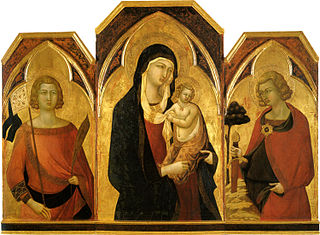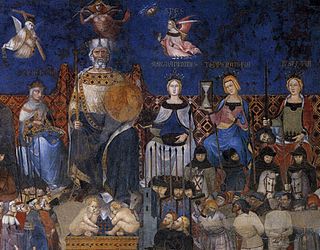
Assisi is a town and comune of Italy in the Province of Perugia in the Umbria region, on the western flank of Monte Subasio.

Ambrogio Lorenzetti or Ambruogio Laurati was an Italian painter of the Sienese school. He was active from approximately 1317 to 1348. He painted The Allegory of Good and Bad Government in the Sala dei Nove in Siena's Palazzo Pubblico. His elder brother was the painter Pietro Lorenzetti.

Pietro Lorenzetti or Pietro Laurati was an Italian painter, active between c. 1306 and 1345. Together with his younger brother Ambrogio, he introduced naturalism into Sienese art. In their artistry and experiments with three-dimensional and spatial arrangements, the brothers foreshadowed the art of the Renaissance.

The Palazzo Pubblico is a palace in Siena, Tuscany, central Italy. Construction began in 1297 to serve as the seat of the Republic of Siena's government, which consisted of the Podestà and Council of Nine, the elected officials who performed executive functions. The palace is of medieval and Gothic architecture, and the interior is lined with frescoes--most importantly, the collection known as The Allegory of Good and Bad Government by Ambrogio Lorenzetti.

The Basilica of Saint Francis of Assisi is the mother church of the Roman Catholic Order of Friars Minor Conventual in Assisi, a town in the Umbria region in central Italy, where Saint Francis was born and died. It is a papal minor basilica and one of the most important places of Christian pilgrimage in Italy. With its accompanying friary, Sacro Convento, the basilica is a distinctive landmark to those approaching Assisi. It has been a UNESCO World Heritage Site since 2000.

Buonconvento is a comune (municipality) in the Province of Siena in the Italian region Tuscany, located about 70 kilometres (43 mi) south of Florence and about 25 kilometres (16 mi) southeast of Siena in the area known as the Crete Senesi. It is one of I Borghi più belli d'Italia.

Santa Maria della Scala is located in Siena, Italy. Now a museum, it was once an important civic hospital dedicated to caring for abandoned children, the poor, the sick, and pilgrims. Revenues were earned partially from bequests and donations from the citizens of Siena, particularly the wealthy. The head of the hospital was the rector who managed the lay brothers responsible for its operation.

San Francesco is a basilica church in Siena, Tuscany, Italy.
Andrea Vanni was an Italian painter of the early Renaissance, active mainly in his native Siena.
The decade of the 1330s in art involved some significant events.
The decade of the 1290s in art involved some significant events.
The decade of the 1320s in art involved some significant events.

The Church of Santa Maria dei Servi is a Romanesque style, Roman Catholic church in the Terzo of San Martino in the city of Siena, Tuscany, Italy.

Bartolomeo Bulgarini, also known as Bulgarino or Bologhini, was an Italian painter of the Trecento period in Siena both before and after the Black Death.

Pietro da Rimini was an early 14th-century Italian painter.

The Allegory of Good and Bad Government is a series of three fresco panels painted by Ambrogio Lorenzetti between February 1338 and May 1339. The paintings are located in Siena's Palazzo Pubblico—specifically in the Sala dei Nove, the council hall of the Republic of Siena's nine executive magistrates, elected officials who performed executive functions. The paintings have been construed as being "designed to remind the Nine [magistrates] of just how much was at stake as they made their decisions".

The Bartolini Salimbeni Chapel is a chapel in the church of Santa Trinita, Florence, central Italy. Its decoration by Lorenzo Monaco, dating to the 1420s, are one of the few surviving examples of International Gothic frescoes in Italy. The chapel has kept other original elements, such as its altarpiece, an Annunciation, also by Monaco, and the railings.

Niccolò di Segna was an Italian painter from Siena. His activity is documented starting from 1331.

Guido Palmeruccio, also called Guiduccio Palmerucci, was an Italian painter, active in Gubbio.
Meo di Pero, also called Meo di Piero was an Italian painter active in Siena in a Gothic style. He worked in the studio of Cristoforo di Bindoccio. All the latter paintings are generally co-attributed to Meo, since no independent work is known.















